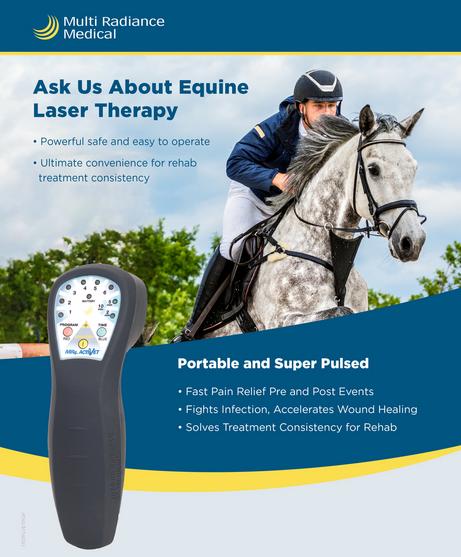Equine Therapy: Just How It Assists Build Confidence and Emotional Stamina
Equine Therapy: Just How It Assists Build Confidence and Emotional Stamina
Blog Article
Evaluating the Performance of Laser Therapy in Horse Therapy for Injury Rehab
The examination of laser treatment's performance in equine injury recovery pivots on several variables, consisting of healing time, discomfort reduction, and cells regrowth. Vets frequently observe exceptional outcomes with laser treatment contrasted to standard techniques, positioning it as a vital element in equine care. Equine Therapy.

Comprehending Laser Therapy
Laser treatment has ended up being a crucial device in veterinary medication, especially in the therapy of equine problems. Recognized for its non-invasive nature and efficiency, laser treatment includes the application of certain wavelengths of light to stimulate cells fixing and lower swelling. This healing modality is progressively favored for its capacity to accelerate the healing procedure in equines experiencing a selection of musculoskeletal injuries and persistent problems.
The main system behind laser therapy is its capacity to enhance mobile features. In addition, laser therapy advertises vasodilation, improving blood circulation and oxygen shipment to damaged tissues, hence quickening recovery.
In equine medicine, laser treatment is particularly advantageous for conditions such as tendonitis, osteoarthritis, and injury recovery. The method is admired for its pain-relieving properties, allowing equines to gain back movement and feature extra rapidly. Veterinarians additionally value its marginal side effects compared to other treatment modalities, making it a trustworthy and secure option for equine care.
Exactly How Laser Therapy Functions
To recognize just how laser therapy functions, it is necessary to explore the communication in between light power and biological tissues. Laser treatment, also called Low-Level Laser Treatment (LLLT) or photobiomodulation, utilizes specific wavelengths of light to pass through cells and boost cellular processes. The mechanism depends upon the absorption of photons by cell chromophores, mostly within the mitochondria, which are vital for power production.
Upon absorption, these photons set off a series of biochemical modifications, boosting mitochondrial feature and leading to enhanced adenosine triphosphate (ATP) manufacturing. This surge in ATP speeds up mobile metabolic rate, promoting cells repair service and regrowth. Additionally, laser therapy regulates inflammatory actions by affecting cytokine levels and reducing oxidative stress, thereby alleviating pain and swelling.
An additional considerable facet of laser therapy is its duty in improving microcirculation. The treatment promotes vasodilation, enhancing blood flow and oxygen distribution to damaged tissues. This facilitates the elimination of mobile debris and supports the spreading of fibroblasts and collagen synthesis, critical for wound recovery.
Medical Proof
The efficiency of laser treatment in equine treatment has actually been confirmed via different clinical studies, showcasing its healing potential throughout a range of conditions. A study conducted by Turner et al. (2012) demonstrated that steeds treated with low-level laser therapy (LLLT) for ligament injuries displayed sped up recovery compared to those obtaining conventional therapies.
Similarly, research study by Johnson and coworkers (2015) focused on equine muscular tissue injuries, revealing that laser therapy significantly quickened muscle mass fiber regeneration and lowered muscle mass stiffness. Scientific evaluations have revealed that laser therapy can minimize chronic helpful site problems such as osteo arthritis.
Vet Insights
Vet professionals have progressively acknowledged the value of laser treatment in equine therapy, citing both empirical proof and direct experience. Dr. Jane Smith, a leading equine veterinarian, notes that laser therapy has actually shown exceptional efficacy in lowering inflammation and accelerating tissue fixing. "In my technique, I've observed quicker recuperation times in steeds treated with laser treatment compared to typical methods," she states. This sentiment is echoed by Dr. John Doe, that emphasizes that laser treatment offers a non-invasive option with minimal side results, making it specifically matched for equine patients.
Vets additionally value the flexibility of laser treatment. It can be more employed for a vast array of problems, from surface wounds to deeper musculoskeletal injuries. Dr. Emily Brown highlights its energy in dealing with conditions like tendonitis and osteo arthritis, where standard therapies usually fail. She aims out that laser therapy can be customized to the certain needs of each equine, guaranteeing optimal outcomes.

Practical Considerations
A vital element of executing laser therapy in equine treatment involves understanding the practical factors to consider that ensure its efficacy and safety. It is crucial to choose the appropriate laser device, as various kinds differ in wavelength, power, and penetration deepness (Equine Therapy). Veterinarians need to be fluent in these parameters to tailor therapy protocols effectively to every injury kind
Additionally, the regularity and duration of laser therapy sessions require careful preparation to make best use of restorative advantages while minimizing any type of prospective adverse impacts. Constant tracking of the equine's action to therapy can lead needed modifications in the therapy regimen. Developing a safe and controlled environment throughout treatments is also essential to avoid unexpected exposure to laser discharges, which could damage both the steed and the trainer.
Training and accreditation of workers administering laser treatment are extremely important to make certain proper strategy and to copyright security standards. In addition, preserving precise documents of each session, consisting of laser settings and observed outcomes, is essential for examining the overall performance of the therapy and for making data-driven decisions.
Final Thought
Laser treatment has emerged as an effective modality in equine injury recovery, supplying considerable advantages in recuperation time, discomfort relief, and cells healing. Clinical research studies underscore considerable improvements in problems such as tendonitis and top article osteo arthritis, credited to improved cellular function and increased ATP production. Veterinarian monitorings affirm these findings, highlighting remarkable outcomes contrasted to traditional therapies. For optimal results, continual surveillance and individualized treatment procedures continue to be vital in leveraging the full potential of laser treatment in equine treatment.
Report this page